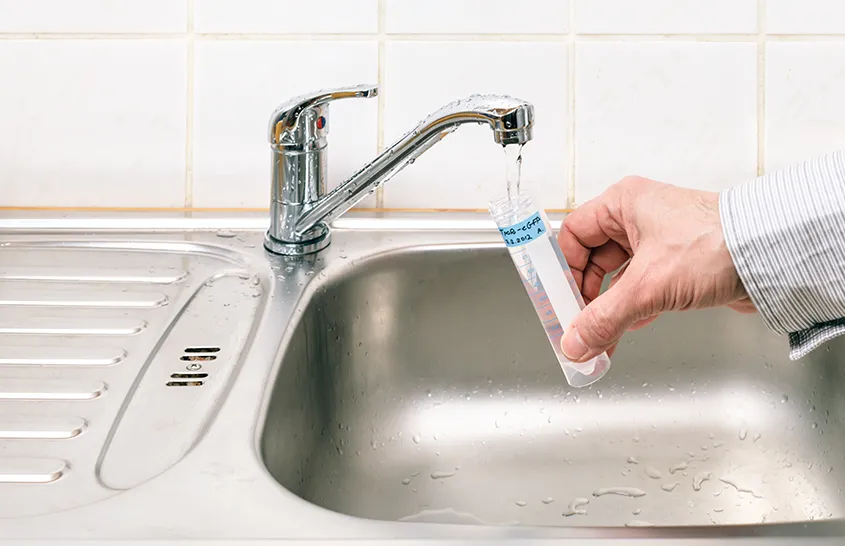Perform drinking water analysis yourself: Many people wonder why this should be necessary. After all, the public waterworks supply flawless drinking water to households. For this purpose, the drinking water ordinance specifies corresponding criteria and procedures as well as regulations. Carrying out a drinking water analysis oneself therefore hardly makes sense, the consumer thinks.
In fact, however, this is not entirely true. Consumers do well to carry out a drinking water analysis themselves. Because this is quite necessary in many cases, as the results of the water analyses and also large-scale studies show again and again. It is not the water that is supplied by the water suppliers, but rather what runs out of the tap at the end, that is often contaminated. Performing a drinking water test yourself with a water testing kit provides certainty, because contamination cannot be completely ruled out despite the strict regulations of the Drinking Water Ordinance. The problem factor, which makes it necessary to carry out a drinking water analysis for private households: the own house installation!
Water testing provides safety
Consumers should carry out a drinking water analysis themselves in addition to the inspections by the waterworks. Because the guarantee of the water suppliers ends at the house-own water metre! From here on, owners are responsible and may have to carry out a drinking water analysis themselves, even apart from the water tests specified in the Drinking Water Ordinance. This makes sense above all to be able to detect contamination at an early stage and eliminate the triggers.
Experts recommend: Carry out the drinking water test yourself
Private households, tenants and consumers in general should carry out a drinking water analysis themselves in addition to the strict official controls. The experts recommend this not because of the quality of the drinking water supplied by the waterworks. The real sources of danger are found in the in-house pipes and fittings. This is where impurities arise that can pose a particular danger to consumers, including lead or copper in drinking water. Particularly with regard to the health of babies and children, these contaminants can lead to long-term problems. However, adults also suffer from drinking water contamination. However, symptoms and illnesses are rarely associated with tap water contamination. Parents’ advisors therefore recommend, just like health experts, that private households should also carry out their own drinking water test on a regular basis and on the basis of the water that actually flows from the taps.
Tap water in old buildings – just drink it or rather test it?
Tap water in old buildings built before the 1970s should generally be checked before drinking it. The reason for this is various impurities that can occur especially in outdated pipes. Among them, in particular, lead, which can mix into drinking water through the pipes installed up to that time.
Lead is one of the main problems when it comes to tap water in old buildings. This is because until about 45 years ago, lead pipes were often used for the in-house tap water network. The dangers posed by this material when used as a water-carrying pipe were not recognised until relatively late.
If lead pipes are installed in the house, the limit value for lead can hardly be complied with. According to the current drinking water ordinance, this limit is 10 µg per litre of drinking water. Tap water in old buildings in which lead pipes are still installed therefore rarely or never complies with this limit value. So even if the water suppliers supply water that complies with the legal requirements, tenants or owners of older apartments cannot be sure that they have truly uncontaminated water at their disposal. This is because the tap water in older buildings is not contaminated before the water supplier hands it over to the consumer, but actually within the home. From the point of transfer, the owner himself is responsible for the quality of the drinking water. Tap water in old buildings should therefore not be consumed until compliance with the limit values has been proven for the water that ultimately flows out of the tap.
Health at risk: tap water in old buildings
Tap water in old buildings poses a particular danger, especially with regard to the health of young children. The consequential damage that can occur as a result of prolonged lead intake through drinking water is enormous. Tap water in old buildings should therefore be subjected to a drinking water analysis before use.
Besides lead, other contaminants can also endanger the health of the drinking water user, especially with regard to tap water in old buildings. Lead, however, is one of the most frequent and most serious factors.
Especially pregnant women and parents of infants as well as small children should not use their tap water in old buildings without control. Lead in drinking water can have an enormous impact on blood formation. This is especially true for children and infants. While the blood-brain barrier normally has the task of protecting the brain from harmful influences, the lead ingested by toddlers and babies can enter the brain unhindered and cause immense problems there. This is because this natural protection is not yet fully developed in our youngest children. Negative factors such as lead can cause damage to the nervous system, which can affect the child’s intelligence development, among other things. Lead can also be absorbed through the mother’s milk. Tap water in old buildings can therefore be dangerous for babies even if they are still completely breastfed and do not consume the water themselves at all.
But tap water in old buildings also poses a long-term danger for adults if, for example, the lead content is too high. Although some of the lead is excreted again, it can also be deposited in the bones and thus sooner or later enter the metabolism.
Testing tap water in old buildings – how to protect yourself
If lead could contaminate the tap water in old buildings, above all no stagnant water should be used. Accordingly, the water should be allowed to drain for some time before it is used. For infants, tap water in old buildings should be avoided until a drinking water analysis provides clarity and action is taken, if necessary.
To be sure that tap water in old buildings does not pose a risk, it should be analysed. This can be done, for example, using the Water Test Kit | Plus, which examines the water for the most important parameters. If limit values are exceeded, the trigger can be located and appropriate measures taken.
Domestic well operators should additionally test their drinking water themselves
The possibility of being able to carry out a drinking water analysis themselves is particularly relevant for operators of their own domestic wells. This self-produced water is not controlled by the water suppliers. Therefore special regulations apply here for the execution of the prescribed water analyses. But even apart from these official water tests, well operators and users of this water can perform a drinking water analysis themselves – with a well water testing.
Drinking water analysis with little effort
In the meantime, it takes very little effort to perform a drinking water analysis yourself. Interested parties can choose from different drinking water analysis sets tailored to their needs in the IVARIO online store and carry them out themselves with just a few simple steps. In addition, a professional and free consultation is offered by phone or email. Carrying out a drinking water analysis yourself thus becomes child’s play and brings certainty.
The various impurities that can occur in drinking water, some of which originate in your own drinking water installation, can cause a wide variety of illnesses, complaints, impairments and symptoms. For example, too much lead in drinking water can lead to developmental disorders in young children. Copper in tap water can trigger gastrointestinal complaints, and pesticides in water obtained through one’s own domestic well can cause damage to the central nervous system. And bacteria and germs in tap water can also be a danger. This list could go on and on, underscoring the need for drinking water analysis for homes, well operators and especially families.
Read more about this here in the IVARIO drinking water magazine or find out directly about our drinking water analyses to carry out yourself in the IVARIO store.


